This is a pretzel, and if you were asked what shape it was, you would probably say it was pretzel shaped. But (by definition) all pretzels are pretzel-shaped. Here are some other pretzel shapes that are a little less common: Pretzels for musicians, writers, gardeners, mathematicians, capitalists and Mac fanboys.

First off, there’s the treble clef, which stands on its own as an interesting pretzel shape. While music geeks might prefer something more esoteric like a bass or alto clef, the treble clef is not only more recognizable but is also more structurally stable– we’ll come back to that point a little later.
For the gardener, we have a snail pretzel. It looks a bit like the Slow Food logo, which is fine since it’s food, and it’s not going anywhere.
There are plenty of typographical symbols that lend themselves to pretzelization. (Yes, “pretzelization” is a word, at least according to the cat.) Here, we’ve pretzeled the ampersand and paragraph symbol, which is apparently called a pilcrow. As you can see, both shapes have become a little bit distorted in the cooking process– that is an unfortunate occupational hazard.
Quite a few possibilities are open to the mathematician, some of which might be lost on the average mustard-loving pretzel eater. For example, you might consider making an integer double-struck-Z symbol (?) but the shape isn’t really sturdy enough to make a great pretzel.
We settled on the simple infinity symbol, but there are probably better choices; you can leave your suggestions in the comments below.
Depending on where you work, these might be the perfect pretzels for your office party. There are lots of other types of currency, and you could probably make pretzels for each type. Here’s an idea: you could make a pretzel version of the traditional currency from yap; you could call it a bagel.
And yes, pretzels for Mac fanboys! These are modeled after the Macintosh command key symbol, which was derived from a sign in a Swedish campground. These were excellent, and next time that we make pretzels we might make them all in this shape.
To make these pretzels, we used the soft pretzel recipe from Baking Illustrated. It begins with a stiff yeast dough made with a lot of honey. It’s left to rise for a couple of hours before being shaped into ropes and then into pretzel shapes on cookie sheets. It’s a very elastic dough, so that rolling step takes some work. The recipe is a traditional one that involves an uncommon step: boiling the shaped pretzels briefly in water laced with baking soda.
Boiling the dough in water produces that perfect bagel-like surface texture and the baking soda causes the surfaces to darken very quickly in the oven. It also leads to one of the most surreal things that you’ll ever see in the kitchen: common symbols like those here being cooked on the stovetop.
After boiling, the pretzels are returned to the cookie sheet, sprinkled with kosher salt, and baked. The bake is fairly short, but they darken very quickly because of the baking soda .
One of the things that I had not previously appreciated about pretzels is that the traditional shape serves an important purpose, maintaining the structural integrity while they are boiled in water. Even though the rolled out ropes of pretzel dough are only about half an inch in diameter, the pretzels can be quite sturdy if the ropes are overlapped well. The command-key symbol, the treble clef, the ampersand, and the dollar sign have excellent overlap and were very easy to work with. Simpler shapes, like the pound sign and euro were harder to flip in the water. Designs, such as the snails, that have little or no overlapping parts are only barely viable, and tend to fall apart in the boiling step. However, go ahead and be adventurous in your design– the worst that will happen if your pretzels fall apart is that you’ll end up with a few extra soft pretzel sticks. (Yum.)




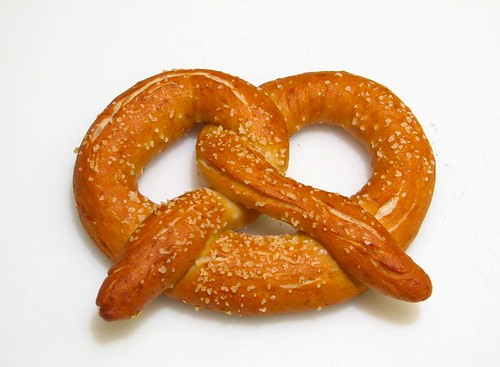
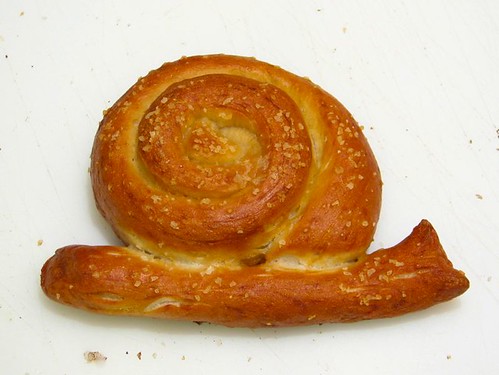
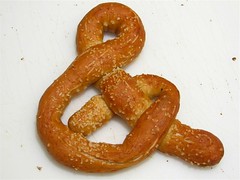
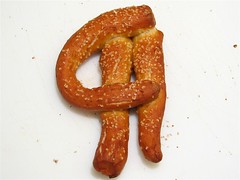
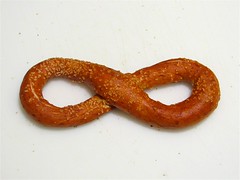
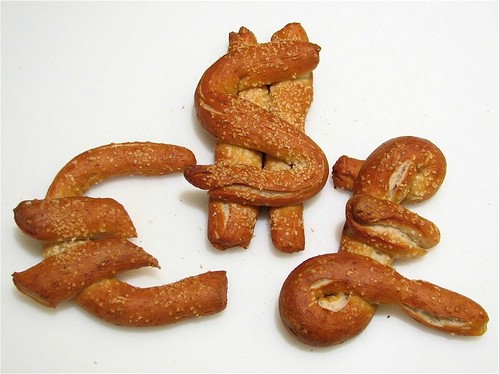
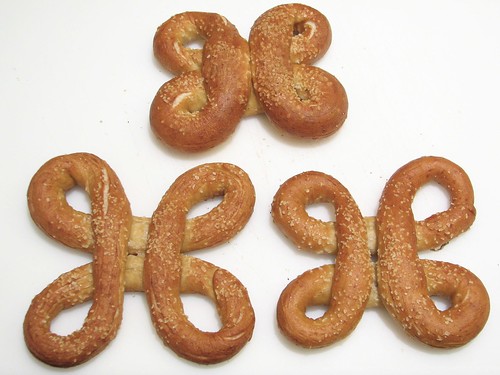
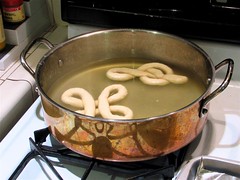
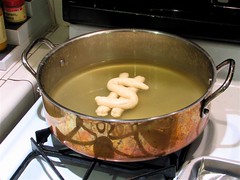

I sure could do with a pretzel right now. If only they could be transmitted through the ‘net.
It seems like it should only be a matter of time until that’s possible. I wonder what Moore’s law says about this!
—
Windell H. Oskay
drwho(at)evilmadscientist.com
http://www.evilmadscientist.com/
Something in this post is breaking the rss feed. http://feedvalidator.org/check?url=http://www.evilmadscientist.com/backend/geeklog.rss
Whoops! Thank you very much for pointing that out– it should be working now.
(The problem was that the Euro and Pound symbols had found their way from being HTML character entities into (illegal) screen display characters. Yuck.)
—
Windell H. Oskay
drwho(at)evilmadscientist.com
http://www.evilmadscientist.com/
They don’t darken quickly because of BAKING SODA, they darken because of the high fructose content because you used a lot of honey. Fructose turns dark quickly when baked (caramelization).
The cookbook that we used claims that the darkening is greatly assisted by using baking soda, and that boiling without the baking soda does not result in pretzels as dark. The exact mechanism of the darkening is not something that is addressed, nor I do not have any evidence for or against fructose being an important part of that process.
—
Windell H. Oskay
drwho(at)evilmadscientist.com
http://www.evilmadscientist.com/
Anyone who’s going to argue food chemistry should have a copy of Harold McGee’s book, "On Food and Cooking". Harold says that because of the alkaline conditions created by spraying the pretzels with lye (industrial pretzel baking) or boiling in baking soda solution, "browning reaction pigments and flavor compounds rapidly accumulate. (The lye reacts with carbon dioxide in the oven to form a harmless edible carbonate).". Harmless, but delicious!
Thanks for the tip! (We have that book, and it kicks ass in an amazing way– but it didn’t occur to me to look it up there. Doh!)
—
Windell H. Oskay
drwho(at)evilmadscientist.com
http://www.evilmadscientist.com/
Not true. The brief simmer in baking soda water alters the pH of the outer dough so that it browns better. Commercial pretzel manufacturers sometimes even use a lye solution for the same purpose.